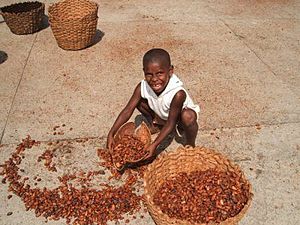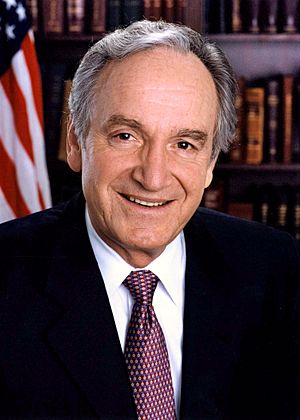Harkin–Engel Protocol facts for kids
The Harkin–Engel Protocol, also known as the Cocoa Protocol, is an international agreement. It was created to stop the worst kinds of child labor and forced labor in the making of cocoa. Cocoa is the main ingredient in chocolate.
This agreement was put together by U.S. Senator Tom Harkin and U.S. Representative Eliot Engel. They acted after news reports in 2000 and 2001 showed that many children were being forced to work in cocoa production. The protocol was signed in September 2001. Later updates in 2005, 2008, and 2010 continued the effort to fix this problem.
The cocoa industry had promised to reduce child labor in Ivory Coast and Ghana by 70% by late 2015. However, this goal was not met, and the deadline was moved to 2020.
What is the Harkin–Engel Protocol?
The Harkin–Engel Protocol is a voluntary agreement. This means companies and governments agreed to it on their own, without being forced by law. It brings together governments, the global cocoa industry, cocoa farmers, workers, and non-profit groups. Their goal is to stop the worst forms of child labor in cocoa farming and processing in Côte d’Ivoire and Ghana.
The agreement focuses on the "worst forms of child labor," as defined by the International Labour Organization (ILO). It doesn't aim to stop all child labor, but only the most dangerous and harmful types.
The Six-Step Plan
The protocol laid out a plan with six main steps:
- Step 1: Acknowledge the Problem
* The cocoa industry publicly admitted that forced child labor was a problem. They promised to use "significant resources" to help solve it.
- Step 2: Form Advisory Groups
* By October 1, 2001, a group was to be formed to study labor practices. * By December 1, 2001, the industry would create its own group to find ways to fix the worst forms of child labor.
- Step 3: Make a Joint Statement
* By December 1, 2001, a statement was to be made at the ILO. This statement would say that the worst forms of child labor must end. It would also identify other ways for children removed from labor to learn and grow.
- Step 4: Create a Cooperation Plan
* By May 1, 2002, a joint program was to be set up. This program would involve research, sharing information, and taking action to make sure standards against child labor are followed. It would also set up a way to check if the standards are being met.
- Step 5: Start a Joint Foundation
* By July 1, 2002, the industry would create a foundation. This foundation would oversee efforts to stop the worst forms of child labor. It would also run projects in the field and share information about the best ways to tackle the problem.
- Step 6: Develop Certification Standards
* By July 1, 2005, the industry was to create and use standards for public certification. This would show that cocoa was grown without any of the worst forms of child labor.
Addressing Forced Labor
In 2001, a Joint Statement was added to the protocol. This statement also aimed to find and stop forced labor (as defined by ILO Convention 29) in cocoa production.
The Harkin–Engel Protocol was a non-binding agreement. This means it was an agreement for the cocoa industry to manage itself without strict legal rules. However, Representative Engel warned that he would try to pass new laws if the deadlines were not met. This agreement was one of the first times an American industry agreed to regulate itself. It was also one of the first times self-regulation was used to deal with a global human rights issue.
See also
 In Spanish: Protocolo Harkin-Engel para niños
In Spanish: Protocolo Harkin-Engel para niños




